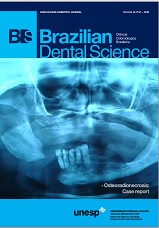Cone-Beam Computed Tomography analysis of prevalence of Nasal Septum Deviation and its relationship with the presence of Middle Concha Bullosa
DOI:
https://doi.org/10.14295/bds.2015.v18i2.1083Abstract
Objetivo: Este estudo teve com objetivo analisar a prevalência do desvio do septo nasal e da presença de concha nasal média bolhosa e estudar a possível relação entre estes por meio de imagens por tomografia computadorizada de feixes cônicos (TCFC).Material e Métodos: Foram selecionados 118 exames de TCFC de arquivo, previamente adquiridos por indicações diversas para odontologia. Todos os exames foram realizados em tomógrafo i-CAT Next Generation (imaging Sciences International, Hatfield, PA, EUA) com o mesmo protocolo, tendo o FOV (Field of View) abrangendo o terço médio e inferior da face. Todas as imagens foram avaliadas no software especifico do sistema por 01 avaliador devidamente treinado. O desvio de septo nasal, a concha nasal média bolhosa e demais dados foram tabulados e realizada a análise descritiva dos mesmos. O teste de McNemar foi aplicado para se estudar a possível relação entre os mesmos. Resultados: Os resultados indicaram que, nos casos em que não ocorria o desvio de septo nasal, 73,5% destes não apresentaram e 26,5% destes apresentaram a concha média bolhosa. Considerando-se apenas os casos que apresentaram o desvio de septo nasal para um dos lados, a proporção que não apresentou a concha média bolhosa para o mesmo lado foi de 77,1% e a que apresentou também a concha média bolhosa para o mesmo lado foi de 22,9%. Conclusão: Concluiu-se que não houve relação (p=0,568) entre a presença das duas variáveis analisadas na pesquisa – desvio de septo nasal e presença de concha média bolhosa.
Palavras-chave: Cavidade nasal; Septo nasal; Tomografia Computadorizada de Feixe Cônico.
Downloads
Downloads
Published
How to Cite
Issue
Section
License
Brazilian Dental Science uses the Creative Commons (CC-BY 4.0) license, thus preserving the integrity of articles in an open access environment. The journal allows the author to retain publishing rights without restrictions.
=================




























